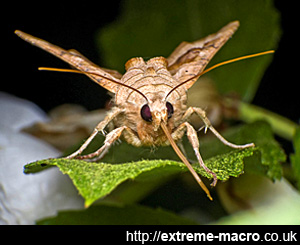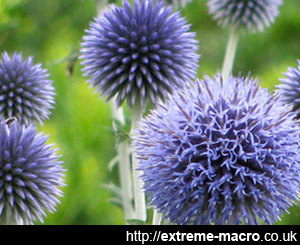Planting For Insects
by Johan J Ingles-Le Nobel
Last updated August 31, 2017
Although each insect tends to have its own type of tree, bush and plant that it uses in its lifecycle, in my garden there are three standout insect performers that I have to draw attention to, and one in particular, the fabulous Eucryphia.
Planting spacific plants to attract the insects of your choice is just one of the various means at our disposal to find insects for photography. There are also various insect traps that can be used to catch insects and they are generally not especially expensive.

Angle Shades moth lolling about with its tongue hanging out on a Eucryphia x nymansensis 'Nymansay' tree in the back garden, shot using the anybrand MP-E 65. Besides attracting bees, bumblebees, flies and hoverflies in their hundreds during the day, Eucryphia x nymansensis 'Nymansay' also works especially well at night, with moths nectaring on it in their hundreds.
If you're going to plant one thing, plant a Eucryphia x nymansensis 'Nymansay' tree, because it doesn't require much garden space and grows up, so is the equivalent of a 100m flowering border to the local insect population. Why grow one piddly plant when you can grow the same as 100s in the same space.
Eucryphia
The slowest to mature, but a complete insect machine once it reaches a few metres tall, Eucryphia is a tree that comes originally from Australasia and grows to about 10m tall over a period of 10 or so years.
Eucryphia x nymansensis 'Nymansay' is an evergreen, with simple leaves and bowl-shaped white flowers in the leaf axils in summer or autumn. Ours always flowers during August.
Insects swarm this tree and go bonkers over the flowers, covering every flower from the top of the tree to the bottom. Even though 'leatherwood' trees are not native to the UK, this tree is covered with more insects during its bloom period than the rest of the valley combined. Literally 1000s.
100 Times Bang For Your Buck
Planting a Eucryphia tree in the garden is an especially efficient method for smaller gardens, because the growth will be vertical so it doesn't need much garden space to do its thing. Most advice for insect planting misses this - way more bang for your buck - plant one this year! Eucryphia also works especially well at night, moths nectar on it in their hundreds and a mothtrap placed below the Eucryphia in the garden catches up to 500 moths in a single night. I would love to see UK conservation bodies plant an acre of these trees somewhere near a forest that has a problem with declining moth species for their food. When I win the lottery it'll be the first field I plant!

Globe thistle, a lovely cottage flower that attracts bees, bumblebees and hoverflies. The spiky leaves and bristly metallic blue flowers of this plant also make it a great architectural plant for the back of a cottage garden border.
Globe Thistle
Great for bumblebees in its flowering months, Echinops 'Taplow Blue' is a robust, upright herbaceous perennial, with divided, prickly dark green leaves whitish beneath. Rounded, steel-blue flower heads on branched, leafy stems.These are 1m tall thistle-like prickly leaved perennials grown in our cottage garden.
Bees, wasps and hoverflies can't resist the huge purple globe-shaped flowers.
Lavender
Who doesn't love seeing a butterfly in the garden gracefully flying from one flower to another looking for nectar. Besides smelling lovely and looking beautiful, Lavender is a great plant to stick in the garden to attack insects, especially butterflies. The only thing about lavender is that it does get leggy so needs a good hack back every years otherwise next year's lavender row is a bit of a disaster. It works well with Sedum mixed in between.
Related Articles





